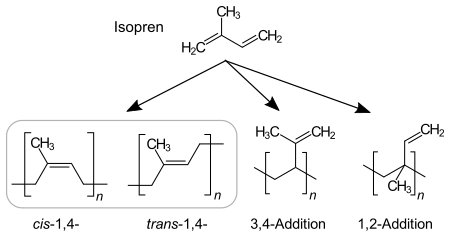Polyisoprene
Polyisoprene is a collective name for polymers that are produced by polymerization of isoprene. In principle, four different isomers can form, see figure. Cis-1,4-polyisoprene, which is also called isoprene rubber, is a major ingredient of natural rubber. Trans-1,4-polyisoprene is a major ingredient of gutta-percha. Annual worldwide production of polyisoprene was 13,000 kilotonne in 2007.[1]
Property

Percentage of repeating units of polyisoprene is depend on reaction mechanism.
Anionic chain polymerization which is initiated by n-Butyllithium produce cis-1,4-polyisoprene dominant polyisoprene. 90–92 % of repeating units are cis-1,4-, 2–3 % trans-1,4- and 6–7 % 3,4-units.[2]
Coordinative chain polymerization: With Ziegler–Natta catalyst TiCl4/Al(i-C4H9)3, more pure Cis-1,4-polyisoprene is formed. Natural rubber is more pure cis-1,4-polyisoprene. With Ziegler–Natta catalyst VCl3/Al(i-C4H9)3, trans-dorminant polyisoprene is formed.[3]
1,2 and 3,4 dorminant polyisoprene is produced MoO2Cl2 catalyst supported by phosphorus ligand and Al(OPhCH3)(i-Bu)2 co-catalyst.[4]
Usage
Natural Gutta-percha and synthesized trans-1,4-polyisoprenes are used for golf balls. Natural rubber and synthesized cis-1,4-polyisoprene are used for elastomer.
See also
References
- ↑ Sebastian Koltzenburg, Michael Maskos, Oskar Nuyken, Polymere: Synthese, Eigenschaften und Anwendungen, Springer, Berlin, 2012, S. 424.
- ↑ Jürgen Falbe, Manfred Regitz (Hrsg.): CD Römpp Chemie Lexikon, Thieme, Stuttgart, 1995.
- ↑ Bernd Tieke, Makromolekulare Chemie, 3. Auflage, Wiley-VCH, Weinheim, 2014, S. 149.
- ↑ 1,2- and 3,4-rich polyisoprene synthesized by Mo(VI)-based catalyst with phosphorus ligand Polymer Science Series B September 2016, Volume 58, Issue 5, pp 495–502